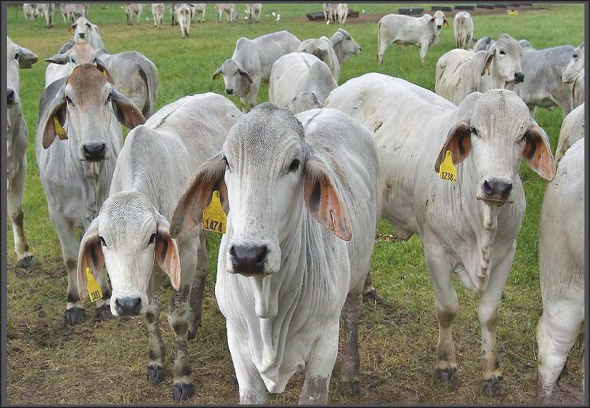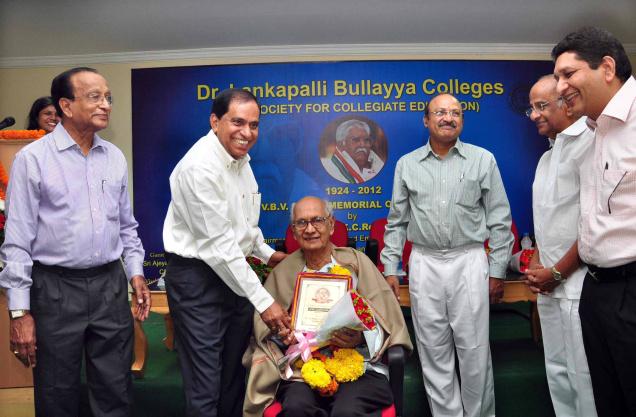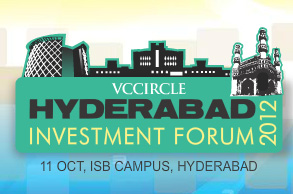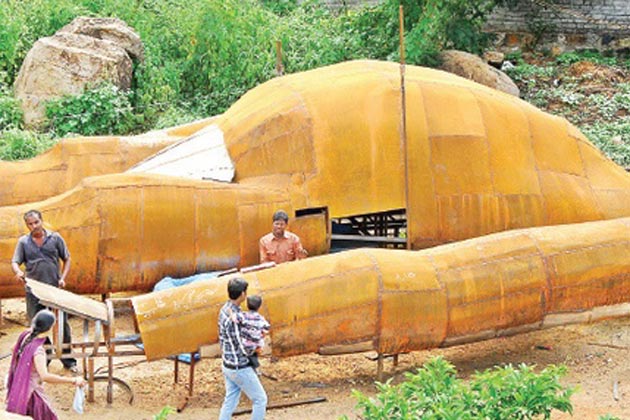
Brahman cattle after a rain near Perch Creek Road near College Station, TX
By Krishan Gupta
History of Brahman cattle between India and America is more than 140 years old. During British Raj Indian cattle were imported to USA and Brazil for milk and other products and according to their needs. Texas became the main hub to import cattle during that time. City of Hungerford, TX has one of the ten largest purebred producers in USA.
A Brahman cow is an extremely good mother, offering protection and an abundance of milk for her calves. Brahman calves tend to measure high weights at weaning because of the outstanding milk given by Brahman cows. They are known for their extreme tolerance to heat conditions, and resistance to insects due to their thick layer of skin. They live longer than many other breeds, often still producing calves at ages 15 and older. These cows have a greater ability to withstand heat than European cattle, and have more sweat glands, big hump, also an oily skin, thought to help repel pest insects along with a smooth coat and a short hair coat. They are also more resistant to parasites and disease in some countries, especially in South America. In South America, Brahman cattles are also used for milk, and other products.
The Brahma is a breed of Zebu cattle (Bos indicus), later exported from India to the rest of the world. The main breeds used were Kankrej, Gujarat, Nellore or Ongole and the Gir cattle. It is named for the Sacred Cow of Hindus.
Nellore cattle originated from Ongole (Bos Iindicus) cattle originally brought from India to Brazil. The Nellore has a distinct large hump over the top of the shoulder, neck, and long legs, which help them to walk in water and when grazing. The Nellore can adapt to all except very cold climates. They are very resistant to high temperatures and have natural resistance to various parasites and diseases.
Ongole city is located in the state of Andhra Pradesh, India and famous for its Ongolu Gittacattle (Ongole breed of oxen). This is one of the major Zebu cattle breeds in the world. Zebucattle was originally called as Bos Indicus, sometimes known as humped cattle, Indicus cattle, Cebu or Brahmin cattle originating in South Asia, particularly the Indian subcontinent. They are characterized by a fatty hump on their shoulders, drooping ears and a large dewlap. Zebu are used as draught oxen, as dairy cattle and as beef cattle, as well as for byproducts such as hides and dung for fuel and manure.
Gir cattle are famous milk cattle breed of India. The native tract of the breed is Gir hills and forests of Kathiawar including Junagadh, Bhavnagar, Rajkot and Amreli District of Gujarat.
Kankrej cattle are a breed of Zebu cattle from the district of Kankrej in the state of Gujarat, India, They are also known by the names Bannai, Nagar, Talabda, Vaghiyar, Waged, Wadhiar, Guzerat cattle are a breed developed in Brazil from Kankrej cattle imported from India. The name Gurezat is a Portuguese spelling of Gujarat. They are, of course, very similar, both being tall draft/beef breeds with high horns. On the average, Guzerat are darker, bigger and have longer horns than Kankrej. The bulls usually are quite dark on the head and forequarters, lighter elsewhere. Guzerat and Kankrej are the principal breeds used in the formation of the American Brahman, along with the Gir and the Nellore.
However there has never existed in India a breed called Nellore. This name corresponds to a District of the old Presidency of Chennai, now belonging to the new State of Andhra Pradesh by the Bengal Sea. It was in Brazil that some authors started to use the name Nellore as a synonym to Ongole, the Indian breed that contributed most to the creation of the Nellore.
The first importation of Indian cattle of any notoriety came in 1854, when sugar and cotton farmer, Richard Barrow of St. Franksville, Louisiana, was presented with two bulls by the Government of Great Britain, for his services in teaching cotton and sugar cane production to British officials establishing these crops in the deltas of India.
In 1915, J.D. Hudgins and his son, Walter, began putting together all of the Indian cattles they could find and afford to purchase. In that year, they bought a group of females which were direct descendants of a 1906 importation from India. In 1924, they were able to purchase a group of bulls which had been imported from Brazil. These, and other humped cattle, formed the basis of the first breed to be developed in the United States “The American Brahman”. The registry for the American Brahman breed was organized in that same year. The J.D. Hudgins ranch is located at Hungerford, Texas, 50 miles southwest of Houston on U.S. Highway 59. The Hudgins Ranch acquired the gray Brahman bull Monso in 1933. Manso’s descendants are the cornerstone stock from which the ranch’s American Gray Brahman herd was developed, now one of the largest registered American Gray Brahman herds in the world.
Originating from a nucleus of approximately 266 bulls and 22 females of several Bos indicus (cattle of India) types imported into the United States between 1854 and 1926. Today the Brahman breed has achieved acceptance for their environmental adaptively, longevity, mothering ability and efficient beef production
In 1933 the Hudgins Ranch purchased the gray Brahman bull Manso, a descendant of a pure blood Brazilian Brahma bred by the Sartwelle Brothers of Palacios, Texas. Manso proved to be an excellent sire and very prolific. His first calves were born in the fall of 1934. At the time of his death in 1943 at the age of 17 years, Manso had produced 316 offspring for the ranch. It has been estimated that over 75% of all cattle registered by the American Brahman Breeders Association carry Manso breeding. The Manso cattle breed have captured over 1500 championships including numerous National and International Champions
V8 Ranch was also established in 1944 by Howard Parker of Center, Texas and purchased by Sloan Williams in 1971. Because of these early roots he said that was proud to be one of the oldest continually operating Brahman herds in the United States.
The American Brahman Breeders Association was organized in 1924. J.W. Sartwelle of Houston was the first recording secretary of the Association and it was he who proposed the word “Brahman” and so it was adopted as the name of the new beef breed. American Brahman cattle, the first beef breed developed in the United States, are proven to be the top most rank in hybrid vigor, heat tolerance, and efficiency compared to all other beef breeds. With improved growth and performance, Brahman cattle increased profitability and play an important role in crossbreeding programs throughout the United States, Brazil, Australia and many other parts of the world.
source: http://www.indoamerican-news.com / September 27th, 2012



